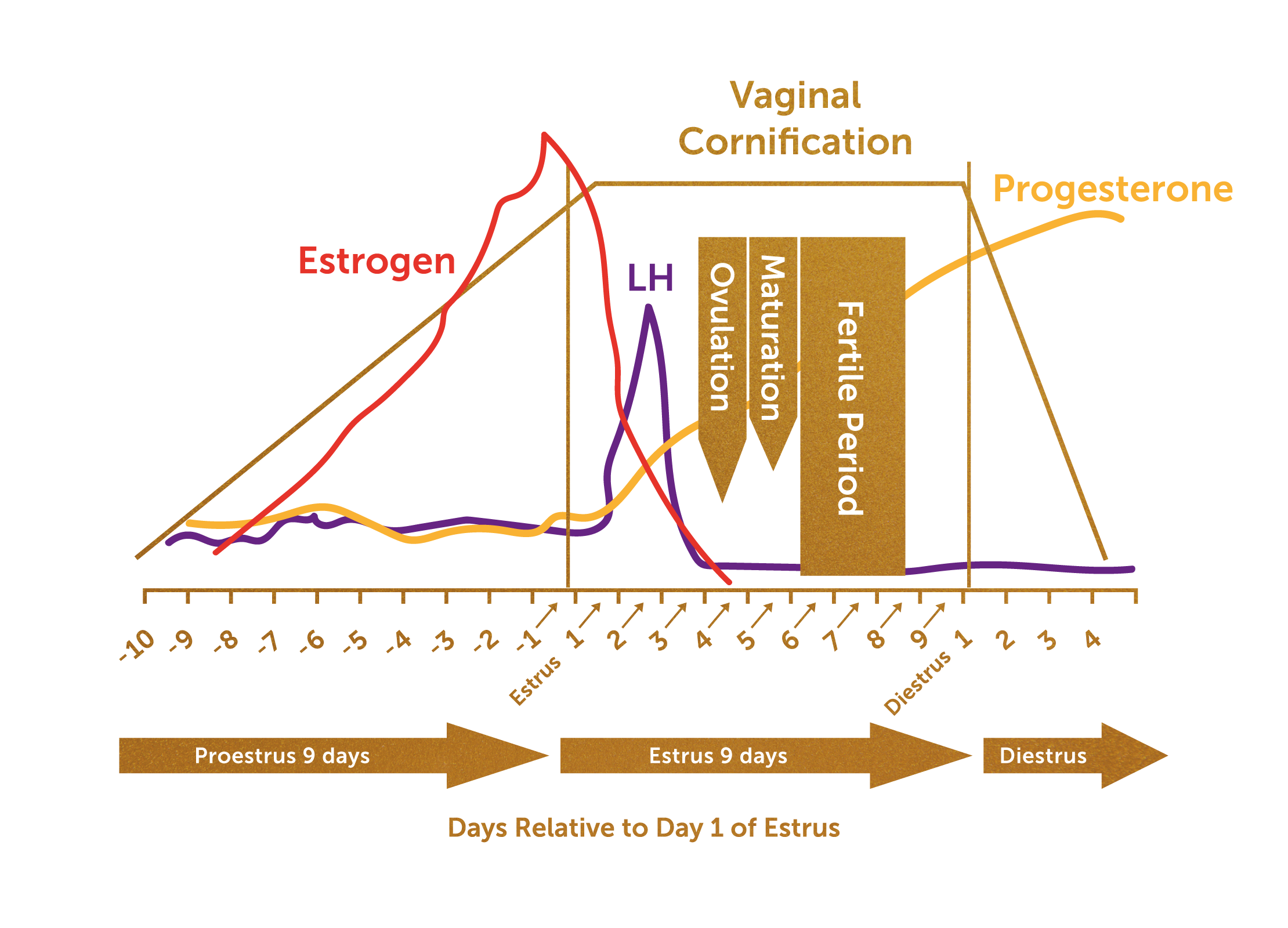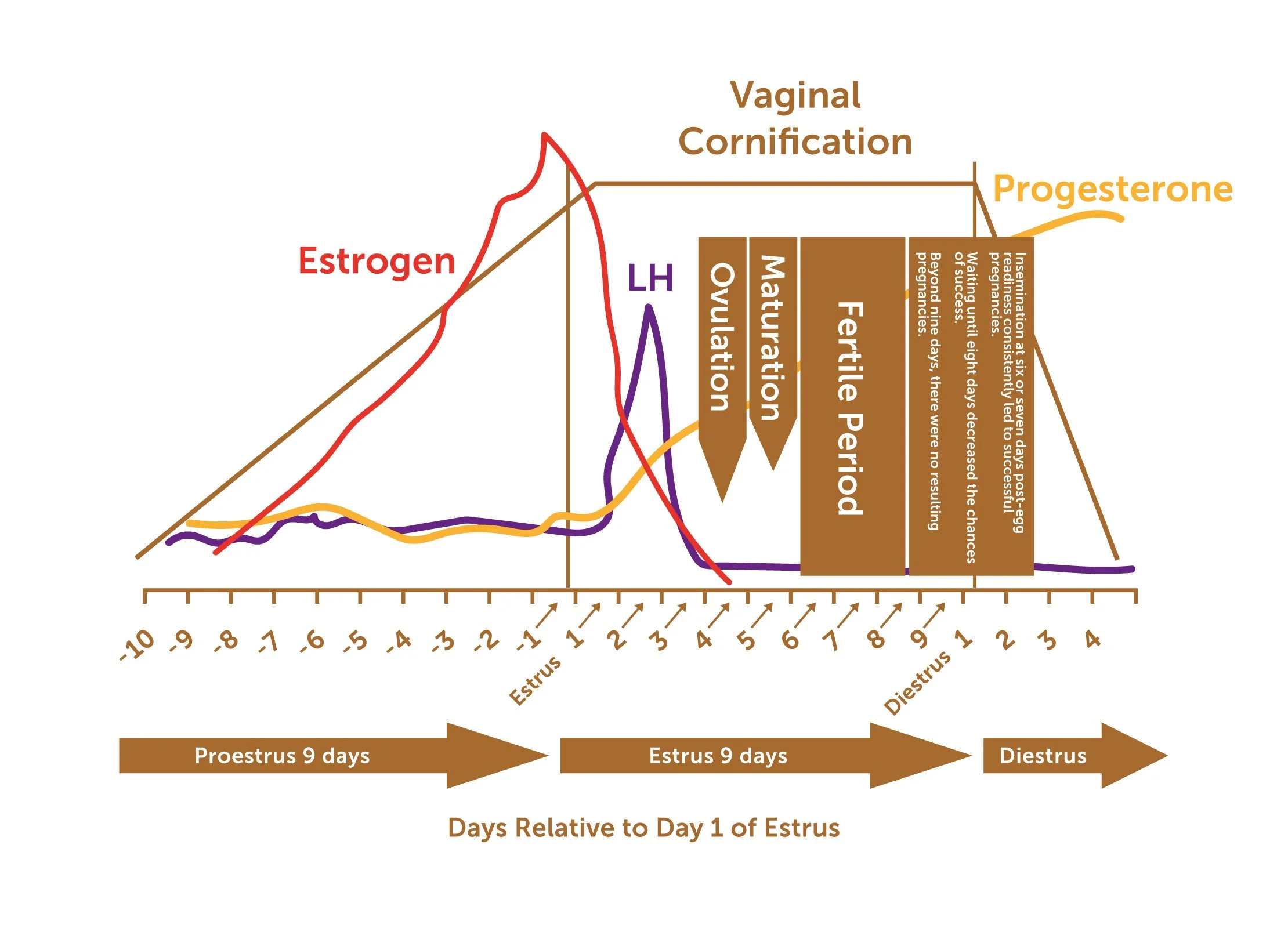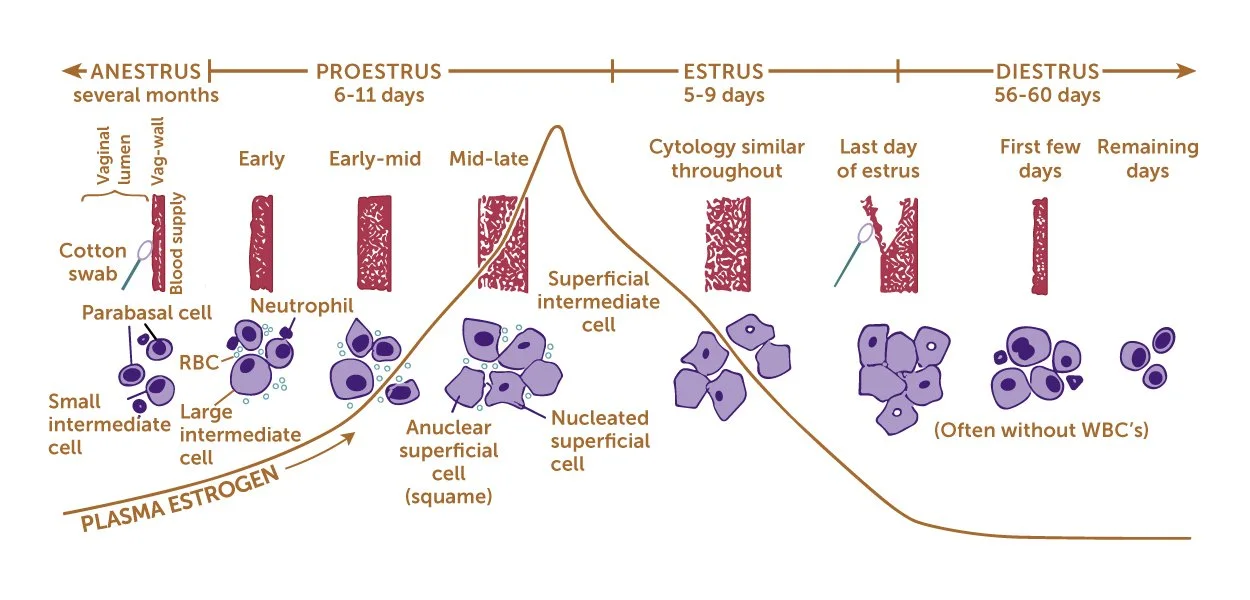Optimizing Doodle Breeding: Understanding Canine Fertility
Doodle breeders aiming for successful breeding know that timing is everything when it comes to pregnancy. Recent research has uncovered fascinating insights into how long female dogs can become pregnant and the best timing for artificial insemination to boost success rates.
Exploring the Fertility Window in Dogs
It turns out that female dogs can become pregnant not just when their eggs are ready, but even a few days after that. The sweet spot for successful mating spans from before the egg is ready to around five days after. After this time, it's tougher for the egg and sperm to connect naturally, but with a little help, pregnancies can still happen up to eight days after the egg is ready.
The first heat happens on average between 6 and 15 months of age. The rule of thumb says that smaller breeds tend to have their first heat at an earlier age, larger breeds later, but this varies between individuals.
Heats appear every 6 months on average. Small-breed females may have up to three seasons per year, while it is normal for giant-breed females to have their heat only once a year.
The heat cycle will last approximately 21 to 28 days.
Female allows mating: for 9 days on average (the estrus stage), but this might vary from 4 days to 24 days.
A dog’s pregnancy lasts on average 63 days from ovulation. Again, there are differences between breeds and individuals. Another reason for variation is that the exact conception time is difficult to determine – even if we knew when the mating happened: sperm can live several days inside the female.
These dates are arbitrary and different for each bitch/dam. Knowing when Ovulation has taken place is the most important metric when panning for an AI.
| US Units (ng/mL) | Intl. Units (nMol/L) | Milestone | Breeding Guidance |
|---|---|---|---|
| 2–5 | 6.5–15 | LH Surge Progesterone begins to rise |
Begin daily testing, prepare for ovulation |
| 6–10 | 20–30 | Ovulation Estimate Day 0 for timing |
Start ovulation-based breeding plans |
| 11–15 | 35–50 | 1st Breeding Window | Ideal for natural breeding or AI #1 |
| 15–25 | 50–80 | 2nd Breeding Window | Follow-up AI or second natural tie |
| 30–40 | 95–125 | Surgical Implant Range | Only use with high-end lab analyzers |
• Natural Tie: 2–3 Days
• AI with Fresh Semen: 3–4 Days (ensure sperm health)
• AI with Frozen Semen: 4–5 Days (verify motility)
Best Practice: Inseminate twice for optimal conception outcomes.
Conversion: 1 ng/mL = 3.18 nMol/L
The Impact of Timing in Artificial Insemination
Insemination at six or seven days post-egg readiness consistently led to successful pregnancies.
Waiting until eight days decreased the chances of success.
Beyond nine days, there were no resulting pregnancies.
Understanding Success Rates and Outcomes
When inseminating at six days post-egg readiness, about 31 out of 100 pregnancies didn't reach full term. The size of the resulting litters and their delivery times varied, with earlier inseminations resulting in larger litters delivered after approximately 64 to 66 days, while the eight-day timing led to smaller litters.
The article supports the idea that through TCI the fertile period is longer than previously believed.
Canine vaginal cytology involves examining cells from a dog's vaginal wall under a microscope to monitor reproductive health. It helps determine the stage of the estrous (heat) cycle in female dogs and is often used in breeding programs or to diagnose reproductive issues. The changes in cell types and structures can indicate where a dog is in her cycle, whether she's in proestrus, estrus, diestrus, or anestrus. This information is crucial for timing breeding or detecting any abnormalities in the reproductive system.
Proestrus: This is the initial stage of the heat cycle. It's characterized by a reddish discharge and swelling of the vulva. Female dogs are not receptive to males at this stage.
Estrus: This is the fertile period when the female is receptive to mating. The discharge becomes lighter or changes color. Ovulation usually occurs during this phase.
Diestrus: If mating hasn't occurred, the female enters diestrus. This phase involves hormonal changes preparing the body for pregnancy. If there's no pregnancy, diestrus ends and the reproductive system returns to a resting state.
Anestrus: This is a period of sexual inactivity and reproductive rest. No hormonal or behavioral signs of heat are present during this stage. It's essentially the resting phase of the reproductive cycle.
Applying Insights for Better Breeding
For Doodle breeders, these findings have practical implications:
Precision Timing: Choosing the right time for artificial insemination greatly impacts success rates.
Minimizing Risks: Knowing when success rates drop allows breeders to avoid less favorable timings, reducing risks for the mother and potential puppies.
Embracing Scientific Insights for Better Breeding
Understanding the extended fertility period and the influence of timing on successful pregnancies opens doors for Doodle breeders. By integrating this knowledge into their practices, breeders can increase success rates, improve breeding programs, and ensure the well-being of future Doodle litters.
In the world of Doodle breeding, grasping the science behind fertility empowers breeders to make informed choices, ensuring healthier and happier generations of these beloved dogs.
Recommendations for when to breed your dog
Progesterone Levels:
Significance: Progesterone levels rise during a dog's heat cycle, indicating the readiness of the ovaries for ovulation and subsequent pregnancy.
Monitoring: Regular blood tests help track progesterone levels. A significant increase suggests ovulation, signaling the optimal time for mating or artificial insemination. These numbers are subject to your testing machine, so check your calibration!
Timing for Mating: Natural mating or artificial insemination is often recommended when progesterone levels reach specific thresholds.
Vaginal Cytology:
Understanding Stages: Vaginal cytology involves examining vaginal cell samples to determine different stages of the estrous cycle.
Cell Changes: The cycle typically starts with proestrus, where there's an increase in cells called epithelial cells. Estrus follows, marked by a shift to cornified cells.
Indications for Mating: Transition from non-cornified to cornified cells signals the fertile phase when the female is receptive to mating and likely near ovulation.
Combined Importance:
Complementary Information: Progesterone levels and vaginal cytology complement each other in predicting ovulation and the fertile window.
Precision in Breeding: Accurate assessment of both progesterone levels and vaginal cytology aids in optimizing breeding timing for natural mating or artificial insemination, significantly enhancing the chances of successful pregnancies.
Understanding these factors helps breeders and veterinarians make informed decisions regarding breeding timing and reproductive health, ultimately contributing to successful breeding programs and the well-being of the dogs involved.
Natural Breeding:
Natural breeding should occur approximately 3 days after the progesterone level reaches 2.5 ng/ml. this is the estimated LH surge.
Sperm in fresh semen can survive for 5-7 days after insemination.
Artificial Insemination with Fresh Chilled Semen:
Recommended for a one-time breeding scenario.
Insemination should take place 4 days after the progesterone reaches the 2.5 ng/ml mark or 48 hours after the 5 ng/ml mark.
Sperm in chilled semen can survive for 48-72 hours after insemination.
Deposition of semen into the cervix is advised to increase the chance of it being drawn into the uterus.
Artificial Insemination with Frozen Semen:
Insemination using frozen semen should be performed 5 days following the 2.5 ng/ml mark or 72 hours after the 5 ng/ml mark.
Sperm in frozen semen survives less than 24 hours after insemination.
Ideally, frozen semen should be deposited directly into the uterus through surgery to increase the chance of pregnancy.
This updated information provides specific timing guidelines for artificial insemination based on progesterone levels and the type of semen used, highlighting the importance of timing and method to maximize the chances of a successful pregnancy.
Conclusion
In the realm of canine reproduction, pinpointing ovulation and the fertile period remains a challenging task. Various methods have been attempted, from traditional approaches like observing behavioral cues in dogs to more technical methods involving hormone assays and vaginal cytology.
Determining the fertile window is crucial for successful conception, especially when using frozen semen. However, accurately predicting ovulation and the ideal time for mating or insemination poses difficulties. Many strategies, including tracking hormone levels like luteinizing hormone (LH) and progesterone, have been employed.
The rise of progesterone is commonly used to predict ovulation, but it's important to note that in canines, the eggs are released before they're ready for fertilization, adding complexity to the timing. Breed variations and individual differences further complicate the process.
Vaginal cytology, though useful in defining the different stages of the cycle, requires expertise and precise techniques to interpret the changes in cell structure throughout the cycle accurately.
In summary, determining the precise fertile period for successful conception in canines is a complex task, often relying on a combination of methods and careful monitoring, with no universally foolproof approach due to the unique nature of each dog's reproductive cycle.
SOURCES:
Arlt, Sebastian. "Canine ovulation timing: A survey on methodology and an assessment on reliability of vaginal cytology." Reproduction in Domestic Animals, vol. 53, no. Suppl 3, Nov. 2018, pp. 53-62.
Concannon, P.W., Hansel, W., Visek, W.J. "The ovarian cycle of the bitch: plasma Estrogen, LH and progesterone." Biology of Reproduction, vol. 13, 1975, pp. 112-121.
Concannon, P.W., McCann, J.P., Temple, M. "Biology and endocrinology of ovulation, pregnancy and parturition in the dog." Journal of Reproduction and Fertility. Supplement, vol. 39, 1989, pp. 3-25.
Concannon, P.W. "Reproductive cycles of the domestic bitch." Animal Reproduction Science, vol. 124, 2011, pp. 200-210.
England, G., von Heimendahl, A. BSAVA Manual of Canine and Feline Reproduction and Neonatology. 2nd ed., BSAVA, 2010.
Hori, T., Tsutsui, T., Amano, Y., Concannon, P.W. "Ovulation day after onset of vulval bleeding in a beagle colony." Reproduction in Domestic Animals, vol. 47, no. Suppl 6, Dec. 2012, pp. 47-51.
Kowalewski, M.P., Ihle, S., Siemieniuch, M.J., et al. "Formation of the early canine CL and the role of prostaglandin E2 (PGE2) in regulation of its function: An in vivo approach." Theriogenology, vol. 83, 2015, pp. 1038-1047.
Reynaud, K., Saint-Dizier, M., Tahir, M.Z., et al. "Progesterone Plays a Critical Role in Canine Oocyte Maturation and Fertilization." Biology of Reproduction, vol. 93, 2015, pp. 1-9.
Reynaud, K., Fontbonne, A., Saint-Dizier, M., et al. "Folliculogenesis, ovulation and endocrine control of oocytes and embryos in the dog." Reproduction in Domestic Animals, vol. 47, no. Suppl 6, Dec. 2012, pp. 66-69.
Tsuchida, M., Komura, N., Yoshihara, T., et al. "Ultrasonographic observation in combination with progesterone monitoring for detection of ovulation in Labrador Retrievers." Reproduction in Domestic Animals, vol. 57, no. 2, Feb. 2022, pp. 149-156.





